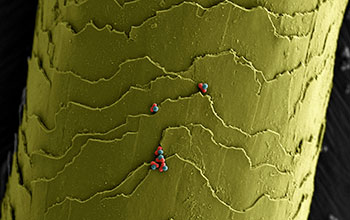Multimedia Gallery
Chemists create microscopic and malleable building blocks
A team of chemists at New York University has created malleable and microscopic self-assembling particles that can serve as the next generation of building blocks in the creation of synthetic materials. Their research focused on engineering particles a micrometer in width -- about 1/200th the width of a strand of human hair -- on which the particles [pink and blue] are placed in this image.
More about this image
A team of New York University (NYU) researchers has created malleable and microscopic self-assembling particles that can serve as the next generation of building blocks in the creation of synthetic materials.
"Our work turns the tiniest of particles from inflexible, Lego-like pieces into ones that can transform themselves into a range of shapes," explains Stefano Sacanna, an assistant professor in NYU's Department of Chemistry and the senior author of a published paper on the study. "With the ability to change their contours, these particles mimic alterations that occur in nature."
The research focused on engineering particles a micrometer in width -- about 1/200th the width of a strand of human hair. Specifically, it aimed to enhance the adaptability of colloids -- small particles suspended within a fluid medium. Everyday items such as paint, milk, gelatin, glass and porcelain are composed of colloidal dispersions, but it’s their potential to control the flow of light that has scientists focused on creating exotic colloidal geometries.
By triggering specific morphological changes in the singular colloidal unit, the Sacanna Group hopes to advance colloidal crystal engineering.
The research was supported in part by the National Science Foundation Materials Research Science and Engineering program (grant DMR 14-20073).
To learn more about this research, see the NYU news release Tiny Transformers: Chemists Create Microscopic and Malleable Building Blocks. (Date image taken: June 2016; date originally posted to NSF Multimedia Gallery: Oct. 4, 2016)
Credit: Stefano Sacanna, NYU
See other images like this on your iPhone or iPad download NSF Science Zone on the Apple App Store.
Images and other media in the National Science Foundation Multimedia Gallery are available for use in print and electronic material by NSF employees, members of the media, university staff, teachers and the general public. All media in the gallery are intended for personal, educational and nonprofit/non-commercial use only.
Images credited to the National Science Foundation, a federal agency, are in the public domain. The images were created by employees of the United States Government as part of their official duties or prepared by contractors as "works for hire" for NSF. You may freely use NSF-credited images and, at your discretion, credit NSF with a "Courtesy: National Science Foundation" notation.
Additional information about general usage can be found in Conditions.
Also Available:
Download the high-resolution JPG version of the image. (632.2 KB)
Use your mouse to right-click (Mac users may need to Ctrl-click) the link above and choose the option that will save the file or target to your computer.



